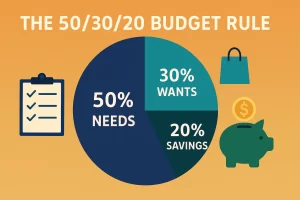Why The 50/30/20 Budget Rule Works for Beginners
The 50/30/20 rule is one of the simplest and most effective budgeting strategies for beginners.
It divides your income into three main categories: needs, wants, and savings. By breaking things down this way, it makes budgeting less overwhelming and gives you a clear path to managing your finances efficiently.
This rule works especially well if you’re just starting out on your savings journey. The goal is not just to save, but to ensure that your budget is balanced and aligned with your financial goals.
What’s your main financial goal right now? Whether it’s building an emergency fund or saving for a vacation, the 50/30/20 rule can help you get there.
Understanding the 50/30/20 Rule

The 50/30/20 rule divides your monthly income into three categories:
- 50% for Needs: This includes all necessary expenses like housing, utilities, groceries, and insurance.
- 30% for Wants: Discretionary spending such as dining out, entertainment, or subscription services.
- 20% for Savings: This portion goes toward emergency savings, retirement, or investing for future growth.
Once you allocate these percentages, your financial life becomes easier to track and manage.
50% for Needs: What Falls Into This Category?
Your “needs” are the essential expenses required to live. These are non-negotiable costs that ensure your basic well-being and stability.
Examples:
- Rent or mortgage payments
- Utilities (electricity, water, internet)
- Groceries and essential items (food, toiletries)
- Insurance (health, car, home)
By sticking to 50% of your income for these needs, you are creating a solid foundation to secure your living situation.
If you find that your needs exceed 50%, consider ways to reduce costs, like moving to a more affordable place or cutting down on utility bills.
30% for Wants: Enjoying Life Without Guilt
Wants are the things that enhance your lifestyle but aren’t absolutely necessary for survival.
This category is where you can have fun, indulge in hobbies, and enjoy entertainment while keeping your budget intact.
Examples:
- Dining out
- Entertainment (movies, concerts)
- Travel
- Subscriptions (Netflix, Spotify, gym memberships)
- Shopping for non-essential items
The key here is to make sure your wants don’t exceed 30% of your income, so you’re still able to prioritize saving and essential needs.
20% for Savings: Building Your Financial Future
Saving 20% of your income might sound difficult, but it’s crucial for long-term financial stability.
This portion should be allocated to both emergency savings and retirement accounts like a 401(k) or IRA.
Emergency savings act as a financial cushion for unexpected expenses.
Once you’ve built up an emergency fund, consider moving some of your savings into higher-interest accounts or low-risk investments.
You can also invest in index funds, which allow you to start small and build wealth over time.
Recommended Tools for Budgeting and Saving Faster (Affiliate Section)
To make budgeting easier, here are some tools that can help you:
- YNAB (You Need A Budget): A fantastic budgeting app that helps you assign every dollar to a specific purpose.
- CIT Bank Savings Builder: Offers a high interest rate, helping your savings grow faster.
- Mint: Track all your spending and monitor your savings with Mint’s free app.
These tools are designed to help you stay on track with your financial goals.
Common Mistakes to Avoid with the 50/30/20 Rule
- Not Tracking Your Spending: Even if you have a budget in place, if you don’t track your spending, it’s easy to slip into bad habits.
- Ignoring Debt Repayment: If you have high-interest debt, make sure to allocate a portion of your “wants” or “savings” to pay it off faster.
- Not Adjusting for Your Lifestyle: Life changes — so should your budget. Adjust your 50/30/20 splits as your income or expenses change.
Stick to the 50/30/20 Rule and Watch Your Savings Grow
The 50/30/20 rule is an easy-to-follow guide that helps you balance your spending and savings while living comfortably.
By allocating 50% to needs, 30% to wants, and 20% to savings, you’re laying the groundwork for financial freedom.
Small Actions Lead to Big Results
The 50/30/20 rule is a simple, effective way to balance your financial life. By following these principles, you can start saving money quickly, plan for the future, and still enjoy your present lifestyle. It’s all about creating balance and making your money work for you, without feeling deprived.
Remember: small, consistent actions lead to big financial results. Get started with this budgeting system today, and take the first step towards a more secure and prosperous financial future.





